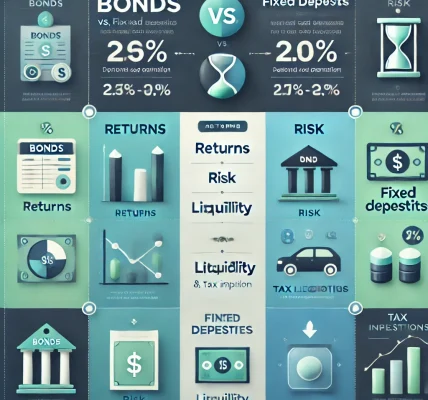Investing in bonds is a popular choice for those seeking stable income and lower risk in their portfolio. However, purchasing individual bonds can be complex and requires a significant amount of capital. Fortunately, you can gain exposure to bonds through mutual funds and Exchange-Traded Funds (ETFs), which make it easier to invest, diversify your portfolio, and manage risk. In this guide, we’ll explore how you can invest in bonds through mutual funds and ETFs, why they are an attractive option, and how to choose the right investment for your financial goals.
What Are Bonds?
Bonds are essentially loans made by investors to organizations such as governments, municipalities, or corporations. When you buy a bond, you’re lending your money to the issuer, and in return, the issuer promises to pay you periodic interest payments (known as the coupon) and return your principal when the bond matures.
Bonds are often considered safer than stocks because they provide predictable income, but the level of risk can vary depending on the type of bond and the creditworthiness of the issuer.
Why Invest in Bonds Using Mutual Funds and ETFs?
Investing in bonds directly can be challenging for individual investors, as it often requires significant capital, knowledge, and resources to buy bonds in bulk. Mutual funds and ETFs provide an easier way for you to invest in bonds by pooling your money with other investors. Here are some benefits of investing in bonds through mutual funds and ETFs:
- Diversification
One of the biggest advantages of using mutual funds and ETFs is the built-in diversification. Rather than buying a single bond, these funds invest in a variety of bonds, which helps spread the risk. This is especially beneficial in mitigating potential losses in case of bond defaults or interest rate fluctuations. - Accessibility
Buying individual bonds requires substantial capital to achieve a diversified portfolio. On the other hand, mutual funds and ETFs allow you to invest in bonds with smaller amounts of money, making them more accessible to beginner and seasoned investors alike. - Lower Fees (ETFs)
ETFs tend to have lower expense ratios compared to mutual funds. This can be especially appealing for long-term investors who are looking to minimize costs. However, the downside of ETFs is that they often come with a commission fee when buying or selling, so it’s important to factor in the trading costs. - Professional Management (Mutual Funds)
Mutual funds are typically managed by professional fund managers who make decisions on bond selection and allocation based on the market’s current conditions. If you don’t have the time or expertise to analyze the bond market, a bond mutual fund can be a great option.
Types of Bond Mutual Funds and ETFs
When investing in bonds through mutual funds or ETFs, you’ll encounter various types, each with its own risk and return characteristics. Here are some of the most common types of bond funds:
1. Government Bond Funds
These funds primarily invest in bonds issued by governments. U.S. Treasury bonds are a common example. They are considered to be among the safest bond investments and are ideal for conservative investors looking for stability and security.
2. Municipal Bond Funds
Municipal bond funds invest in bonds issued by state and local governments. These bonds often offer tax-exempt interest income, making them an attractive choice for investors in higher tax brackets.
3. Corporate Bond Funds
Corporate bond funds invest in bonds issued by corporations. These bonds offer higher yields than government bonds but come with slightly higher risk. Companies with higher credit ratings are considered safer, while lower-rated companies offer higher returns but with increased risk.
4. High-Yield Bond Funds
Also known as junk bonds, these funds invest in bonds with lower credit ratings. While they come with higher risk, they also offer higher returns. High-yield bond funds can be a good option for more risk-tolerant investors seeking higher returns.
5. International Bond Funds
International bond funds invest in bonds from countries outside your own. They provide exposure to foreign markets and can help diversify your portfolio even further, although they carry additional risks such as currency fluctuations and geopolitical instability.
How to Choose Between Bond Mutual Funds and ETFs
When deciding whether to invest in bond mutual funds or bond ETFs, there are several factors to consider:
- Cost: ETFs typically have lower fees than mutual funds, making them a better choice for long-term investors looking to minimize costs. However, mutual funds are actively managed, which can be appealing if you want professional management and research.
- Liquidity: ETFs trade on stock exchanges, so you can buy or sell them throughout the day, much like stocks. Mutual funds, however, can only be bought or sold at the end of the trading day at the net asset value (NAV) price.
- Investment Goals: If you prefer a hands-off investment strategy, a mutual fund managed by professionals may be more suited to your needs. On the other hand, if you’re comfortable with self-managing your portfolio and want flexibility, ETFs may be a better fit.
How to Get Started with Bond Mutual Funds and ETFs
Here are some practical steps to help you get started:
- Determine Your Investment Goals
Before investing, identify your investment goals. Are you looking for steady income, or are you more focused on capital preservation? Your goals will influence the type of bond funds or ETFs you should choose. - Research Funds
Use online platforms or consult with a financial advisor to find bond mutual funds or ETFs that align with your objectives. Look for funds with low expense ratios, a solid performance history, and a diversified portfolio of bonds. - Open an Investment Account
To invest in bond funds, you’ll need to open an investment account. This could be a brokerage account for ETFs or a retirement account for bond mutual funds. Choose a platform that offers low fees, ease of use, and a wide selection of bond funds. - Monitor and Rebalance Your Portfolio
After investing, keep an eye on your portfolio. Interest rates, inflation, and market conditions can impact bond performance, so it’s essential to rebalance your investments regularly to ensure they stay aligned with your goals.
Conclusion
Investing in bonds through mutual funds and ETFs is a practical and efficient way to add fixed-income securities to your portfolio. By understanding the benefits of both options and choosing the right type of bond fund for your needs, you can manage risk, achieve steady income, and diversify your investments. Whether you are a beginner or an experienced investor, mutual funds and ETFs offer a simple solution for gaining exposure to the bond market.
By considering your financial goals and risk tolerance, you can make smarter decisions and enjoy the benefits that come with bond investing. Start researching your options today and take the first step towards building a diversified, stable portfolio!




